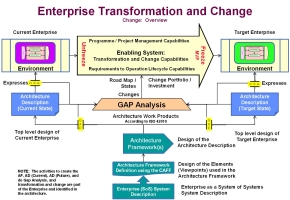Name: Enabling System
Class: Organization
Abstract System: This system has been identified as an abstract system that cannot be implemented directly. The abstract system establishes a shared pattern of characteristics that any system can use to describe its unique characteristics when referenced in the 'based on' list above. These references are described using a generalization association in UML.
The Enabling System is defined as:
ISO 15288:2015: enabling system: system that supports a system-of-interest during its life cycle stages but does not necessarily contribute directly to its function during operation.
The enabling system is also called:
-
Change and Transformation Programme or Project
-
New Product / Service Development Programme or Project.
-
Change Initiative
The enabling system is realized as an organization through the realization of a set of capabilities. See System Element: Capabilities.
The stated or implied purposes of the system-of-interest
The purpose of an enabling system is to help progress a system-of-interest through its development life cycle or provide support during operation. This type of system provides support to operational capabilities and systems. Examples of Enabling Systems are:
- New Product / Service Development Programmes and Projects
- Business Transformation Programmes and Projects
- IT or other related Technology Development programmes and projects
In addition, there may be some operational systems that take on a role of an enabling system. For example, the following are supporting systems to operational capabilities:
- Product Production Systems.
- Product Transportation and distribution systems
Systemic Measurable Variables
-
Cost of the enabling system.
-
Schedule (milestones for key phases / stages and dependencies)
-
Time to market (for new product development)
-
Number of faults and corrective actions.
-
Resources (people and other assets) planned and used.
Systemic Capabilities or Functions
The enabling system provides planning, specification, architecture and design, implementation, integration and release. Other types of enabling systems provide support through the creation or delivery of elements that are part of the system of interest.
These capabilities are delivered through a set of capabilities realized through an organization. See System Element: Capabilities.
System States
The various defined states that the system-of-interest can be in.
- Architectural states (Current State, Intermediate State(s), Target State)
- Transformational States (planned, delivering, stage gate complete, complete)
- Operational States (Started, operating, closed)
Identify the key stakeholders and their concerns for this system. Each stakeholder is identified and their concerns and interests are identified. The list below is an example. Each system will have a specific set of stakeholders and concerns.
- Owner / manager:Does the business case justify the investment in the system-of-interest?
- System Architect: Are the system concepts understood? Are the system properties sufficient to deliver the objectives? Are the states defined and more detailed life cycles understood?
- People in the environment Will the people in the system-of-interest recognise the value of the enabling system?
- Change Agents Are the program or project teams fully aware of the purpose / objectives / contribution of this enabling system?
- People who are part of the system Are the people in the enabling system fully aware of their impact on the system-of-interest they are supporting?
The environment and the potential impacts on the system-of-interest.
this section includes
- Transactional
- External
- Regulator
The Environment for the enabling system includes the 'system-of-interest', other supplier systems, and management systems.
Typically these enabling systems will be organizations or enterprises in their own right. This means they will consist of management systems and technology systems unique to the systems-of-interest they are supporting.
See the Organization as a system for further information about the structure of an organization and the capabilities that are typically included.
PDF: System Description: Organization as a SoS,
PDF: System Description: Capability as a System,
Project or program style enabling systems tend to use the following capabilities along with innovation and change life cycle processes.
Primarily:
-
Program Management.
-
Project Management.
-
Procurement
-
Team Performance Management.
-
People Development
-
Asset Management
-
Organization Design (typically called Enterprise Architecture)
The primary interactions of the enabling system and the system-of-interest are through the changes to the system elements of the System-of-interest.
Configuration / Scenario:
Describes any configuration / scenario attributes for a specific system-of-interest. This may not be appropriate for all system descriptions (e.g. patterns or abstract systems).
Cyclical (Repeating / Regular) Processes
The enabling systems must match the needs of the system elements of the system-of-interest. These system elements may have their own unique life cycles that are managed within the enabling system.
Typical cyclical processes are:
Management Processes (planning, monitoring, reporting, etc).
Technical Processes (Formal Technical reviews, Testing, Change control, etc.)
Development Life Cycle Processes
The enabling systems are created, used and released as part of the overall change or transformation of an Organizationor Enterprise (SoS) or Technology System.
The typical steps for transformation and change are shown in the following diagram:
The steps associated with the model are:
The following references support this type of system-of-interest.
